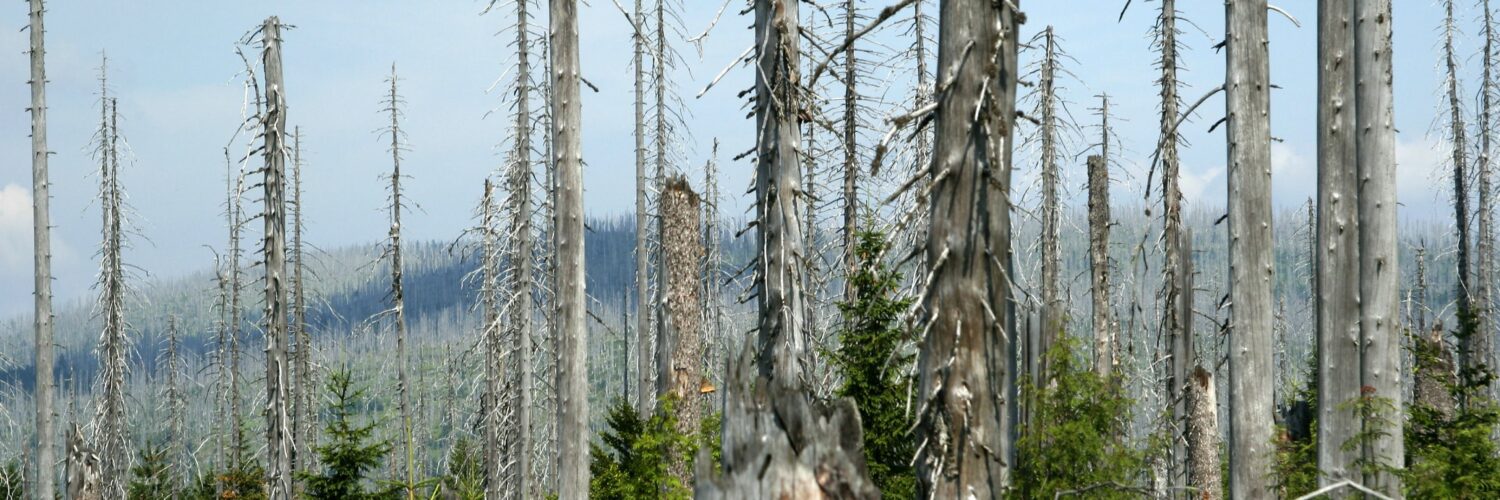Acid rain is a form of precipitation that contains acidic components. Acid rain, likewise known as acid deposition, is precipitation with a pH of 5.2 or below that is often caused by human activities such as the combustion of fossil fuels which emit sulfur dioxide (SO₂) and nitrogen oxides. Acid rain refers to the various ways acidity can travel from the atmosphere to the earth’s surface. Acid rain includes other types of wet acidic deposition like snow, sleet, hail, and fog.
A distilled water for human consumption has a pH level of 7. While a pH level of 7 is considered neutral, anything greater than 7 is alkaline, and below is acidic. Acid rain has a pH of 4.2 or 4.4, while normal rain is slightly acidic with a pH ranging from 6 to 5.6. Acid rain is not a direct concentrated acid from the clouds. It’s a type of rainfall mixed with acidic gases, therefore increasing the precipitation’s acidity.
Acidity
The hydrogen ions (H+) concentration in a solution is measured by acidity. The pH scale determines the acidity or the concentration of base in a solution. When below the pH of 7, substances are considered acidic, and each unit of pH below 7 is 10 times more acidic or holds 10 times more H+ than the one above it. A Rainfall with a pH of 5.0, for example, has 10 micro equivalents of hydrogen per liter, whereas rainwater with a pH of 4.0 contains 100 micro equivalents of hydrogen per liter.
Causes of Acid Rain
When nitrogen oxides (NOx) and sulfur dioxide (SO₂) are released into the atmosphere and carried by wind and air currents, acid rain occurs. NOx and SO₂ react with water, oxygen, and other molecules to form sulfuric and nitric acids. Sulfuric and nitric acids then fall to the earth after mixing with precipitation.
Due to the absorption of carbon dioxide (CO₂) from the atmosphere — a process that produces carbonic acid and organic acids through biological activity — normal rainfall is slightly acidic. Some of the NOx and SO₂ that create acid rain come from natural sources like volcanoes. Depending on emissions associated with individual volcanoes, volcanic activity can produce sulfuric acid, hydrochloric acid, and nitric acid. However, the majority of acidic gases causing acid rain come from the combustion of fossil fuels. The natural formation of nitrogen oxides from the conversion of molecular air nitrogen (N₂) by lightning bolts and the conversion of organic nitrogen by wildfires are two more natural sources of acidity.
Most acid rain results from human activities. According to National Geographic, fossil fuel burning by humans for energy is a major cause of acid rain. Activities such as burning coal to generate electricity release acidic gases that mix with the atmosphere then form acid rains. The use of oil and gas to generate power or run factories is another way humans burn fossil fuels.
Effect of Acid Rain
The acidic constituents of acid rain are not primary greenhouse gases (GHG). Yet, nitrogen oxide, one of these acids, is a pollutant harmful to human health. Acid rain spreads through different means after it falls on the earth’s surface. It flows through runoff water into big bodies of water and sips deep into the soil in some cases. Abiotic components such as water bodies like lakes, wetlands, rivers, and others become acidic through acid rain. Acid rain can impair biodiversity and lower the pH of surface waters in acid-sensitive areas. It debilitates (weakens) trees and makes them more vulnerable to other detrimental factors such as drought, extreme cold, and pests. Acid rain depletes the soil and deprives plants of nutrients.
Acid rain harms the ecosystem. It impacts the abiotic and biotic components in the environment. Sulfur dioxide and nitrogen oxides are harmful to the environment and the lives within. In an ecosystem, acid rain can directly or indirectly affect various forms of life. For example, aquatic lives are direct victims of it while the birds through the food chain suffer indirectly. At a certain altitude, it combines with fog to damage vegetation like forest trees.
As an abiotic part of the environment, the soil loses its calcium and gets saturated with aluminum that affects the proper absorption of water by trees. Furthermore, trees are less healthy and become prone to insects and diseases. Acid rain, in combination with other stressors, makes it difficult for trees to reproduce. In some cases, the soil can neutralize acids, allowing the trees on it to grow. But for some soils without the capability to counteract the acid, the severe effect of acid rain is severe on plants that grow on it.
Acid rain negatively impacts human lives via air contamination. It can lead to asthma, eye irritation, or other health problems as it is sometimes exposed to humans in the form of fog. Acid rain gradually destroys a variety of natural and human-made structures. Historic buildings and monuments across Europe are deteriorating fast. The stones utilized in the construction of these structures are undergoing weathering. As much as this sort of reaction is natural, acid rain is accelerating the process. Through dissolution and alteration, the acids will react with stones leading to a gradual breakdown. If this process continues at this fast rate, all of these buildings may be lost prematurely, including sculptures and objects carved with stones.
Solution
Curbing the release of pollutants will help to reduce the occurrence of acid rain. This would require the reduction of fossil fuels burnt and the adoption of sustainable energy sources like wind and solar power. Setting standards to minimize the emission of sulfur dioxide and nitrogen oxides will help curtail the number of acidic gases in the air. According to scientists, one alternative is to use coal with lower sulfur content. Another technique is to “wash” the coal to remove some sulfur. Reducing energy consumption is another way to prevent acid rain; this includes turning off unused lights and electronics such as televisions and computers and buying equipment that consumes less electricity. Ultimately, these steps will reduce the acidity of rain.





Add comment